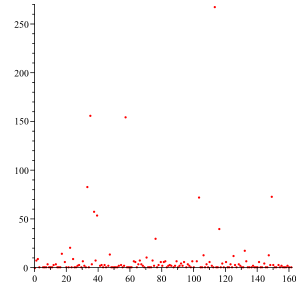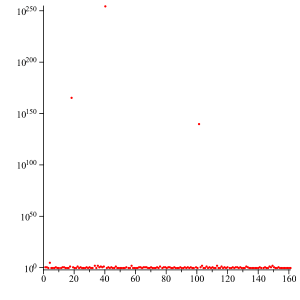Champernowne constant
In mathematics, the Champernowne constant C10 is a transcendental real constant whose decimal expansion has important properties. It is named after economist and mathematician D. G. Champernowne, who published it as an undergraduate in 1933.[1]
For base 10, the number is defined by concatenating representations of successive integers:
Champernowne constants can also be constructed in other bases, similarly, for example:
- C2 = 0.11011100101110111… 2
- C3 = 0.12101112202122… 3.
The Champernowne constants can be expressed exactly as infinite series:
where ceiling( ), in base 10, and is the base of the constant.[2]
A slightly different expression is given by Eric W. Weisstein (MathWorld):
where floor( ).
The Champernowne word or Barbier word is the sequence of digits of Ck.[3][4]
Normality
A real number x is said to be normal if its digits in every base follow a uniform distribution: all digits being equally likely, all pairs of digits equally likely, all triplets of digits equally likely, etc. x is said to be normal in base b if its digits in base b follow a uniform distribution.
If we denote a digit string as [a0,a1,...], then, in base ten, we would expect strings [0],[1],[2],...,[9] to occur 1/10 of the time, strings [0,0],[0,1],...,[9,8],[9,9] to occur 1/100 of the time, and so on, in a normal number.
Champernowne proved that is normal in base ten,[1] while Nakai and Shiokawa proved a more general theorem, a corollary of which is that is normal for any base .[5] It is an open problem whether is normal in bases .
Continued fraction expansion


The simple continued fraction expansion of Champernowne's constant has been studied as well. Kurt Mahler showed that the constant is transcendental;[6] therefore its continued fraction does not terminate (because it is not rational) and is aperiodic (because it is not an irreducible quadratic).
The terms in the continued fraction expansion exhibit very erratic behaviour, with huge terms appearing between many small ones. For example, in base 10,
- C10 = [0; 8, 9, 1, 149083, 1, 1, 1, 4, 1, 1, 1, 3, 4, 1, 1, 1, 15,
- 4 57540 11139 10310 76483 64662 82429 56118 59960 39397 10457 55500 06620 04393 09026 26592 56314 93795 32077 47128 65631 38641 20937 55035 52094 60718 30899 84575 80146 98631 48833 59214 17830 10987,
- 6, 1, 1, 21, 1, 9, 1, 1, 2, 3, 1, 7, 2, 1, 83, 1, 156, 4, 58, 8, 54, ...]. (sequence A030167 in the OEIS)
The large number at position 19 has 166 digits, and the next very large term at position 41 of the continued fraction has 2504 digits. The fact that there are such large numbers as terms of the continued fraction expansion is equivalent to saying that the convergents obtained by stopping before these large numbers provide an exceptionally good approximation of the Champernowne constant.
It can be understood from infinite series expression of : for a specified we can always approximate the sum over by setting the upper limit to instead of . Then we ignore the terms for higher .
For example, if we keep lowest order of n, it is equivalent to truncating before the 4th partial quotient, we obtain the partial sum
which approximates Champernowne's constant with an error of about 1 × 10−9. While truncating just before the 18th partial quotient, we get the approximation to second order:
which approximates Champernowne's constant with error approximately 9 × 10−190.
Irrationality measure
The irrationality measure of is , and more generally for any base .[7]
See also
- Copeland–Erdős constant, a similar normal number, defined using the prime numbers
- Liouville's constant, another constant defined by its decimal representation
References
- 1 2 Champernowne 1933
- ↑ John K. Sikora: Analysis of the High Water Mark Convergents of Champernowne's Constant in Various Bases, in: arXiv:1408.0261, 1 Aug 2014, PDF, see Definition 9
- ↑ Cassaigne & Nicolas (2010) p.165
- ↑
- Allouche, Jean-Paul; Shallit, Jeffrey (2003). Automatic Sequences: Theory, Applications, Generalizations. Cambridge University Press. p. 299. ISBN 978-0-521-82332-6. Zbl 1086.11015.
- ↑ Nakai & Shiokawa 1992
- ↑ K. Mahler, Arithmetische Eigenschaften einer Klasse von Dezimalbrüchen, Proc. Konin. Neder. Akad. Wet. Ser. A. 40 (1937), p. 421–428.
- ↑ Masaaki Amou, Approximation to certain transcendental decimal fractions by algebraic numbers, Journal of Number Theory, Volume 37, Issue 2, February 1991, Pages 231–241
- Cassaigne, J.; Nicolas, F. (2010). "Factor complexity". In Berthé, Valérie; Rigo, Michel. Combinatorics, automata, and number theory. Encyclopedia of Mathematics and its Applications. 135. Cambridge: Cambridge University Press. pp. 163–247. ISBN 978-0-521-51597-9. Zbl 1216.68204.
- Champernowne, D. G. (1933), "The construction of decimals normal in the scale of ten", Journal of the London Mathematical Society, 8 (4): 254–260, doi:10.1112/jlms/s1-8.4.254 .
- Nakai, Y.; Shiokawa, I. (1992), "Discrepancy estimates for a class of normal numbers", Acta Arithmetica, 62 (3): 271–284 .